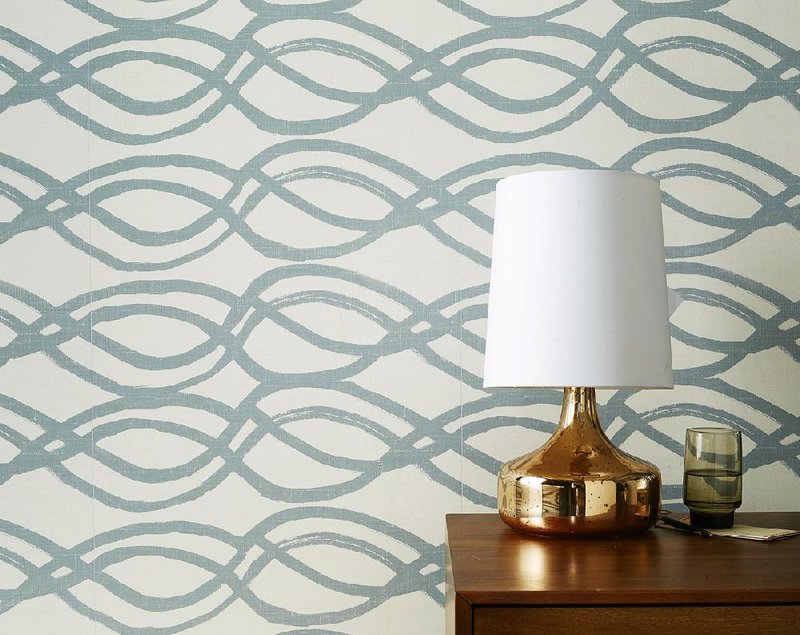Traditionally I have not been a fan of patterned wallpaper. I have always liked it in principle, and would happily use just about any design as wrapping paper, but when it comes to installing it in a room, I have rarely been able to do it. (I distinguish patterned paper from grasscloth and other solid textured coverings, which I use all the time, mostly because they, like paint, provide a neutral backdrop for almost all decorating schemes.) I have found that committing my walls to one design not only restricts my ability to use pattern elsewhere in the room but also limits me from making changes and updates to the room over time.
For those reasons, I have installed patterned wallpaper only a few times in my decorating career, and every time I have used designs with a lot of white space, which has kept the room looking fresh and not too overdone. And when I have used it, it has always been in small rooms, like powder rooms, closets and cozy nooks. Case in point: In my old house, I used Albert Hadley’s Reddish Rose (available through designers) in my daughter’s tiny, under-the-eaves bedroom. The two-color pattern is predominantly white, so the room remained airy, but the wispy roses gave the awkward wall spaces some much needed visual interest.
But lately my ambivalence about wallpaper has been replaced by a sudden willingness to cover every wall. Maybe it’s because I am just seeing more of it. These days wallpaper is on a roll (pun intended). Retailers such as CB2, West Elm, Ballard Designs and Anthropologie, as well as a myriad of other retail sources - plus the classic trade-only sources -sell wall coverings that range in design from the dynamic to the demure, from the natural to the photo-realistic. In part, this craze can be chalked up to fashion; prints are hot. And as we so often see, runway trends quickly make their way into the interior design world. But there is another reason wallpaper is experiencing a renaissance: technology.
Advances in digital imaging have made it possible to create complicated designs that were, until recently, impossible to achieve. Jeanne McComsey, design director of prints at Schumacher, explains that with digital imaging, “you can print hundreds of colors and textures that you could not do with traditional screen or block printing methods.” Take, for example, Schumacher’s new marble prints from Martyn Lawrence Bullard, which were inspired by trompe l’oeil techniques from the legendary decorator Renzo Mongiardinoas well as from classic Venetian marbled paper. Such complex patterns that capture every vein and gradation of color could not have been achieved without digital processing;to the naked eye, these lapis, Carrara and topaz designs look like the real thing. Like Schumacher, Brett Design has capitalized on this technology to produce papers that replicate malachite, snakeskin and even quilted fabric.
The same technology has enabled designers to blow up photographs into giant wall applications. At Murals Your Way you can choose from hundreds of images or upload your own photo, and they will enlarge it to custom fit your wall. Such advances have made wall coverings more appealing to people who, in the past, may have rejected the trend because of its granny, flowery stereotype.
Other advances in application have made the use of wallpaper more democratic. Traditionally, wallpaper has been an expensive option: The paper itself is costly, as is the installation. But pre-pasted and paste-free designs have changed that.
Recently, West Elm launched several pre-pasted designs that require only water to activate the glue. (This is the company’s first foray into wallpaper; more patterns will be launched in the fall.) Peter Fowler, West Elm’s head merchant for decorative accessories, says that putting it up “is definitely a DIY project,” by which he means the process isn’t hard, it just takes some time, particularly when you have to match a pattern.
The company decided not to produce paste-free papers, which are essentially large wall decals, Fowler explains, because the peel-and-stick decals “can be quite challenging,” particularly when you are dealing with big walls. The decals are super sticky, and it’s hard to avoid bubbling. Still, peel-and-stick papers, which are removable, are a good option for renters who in the past had to live with ho-hum beige walls.
Another reason wallpaper is so appealing right now is that there are any number of talented designers who are showing us how to hang it right. Tom Scheerer has single-handedly popularized Quadrille’s Lyford Trellis pattern. He has skillfully used the chinoiserie-style bamboo design in small and large rooms alike. The reason it works: The pattern gives the rooms a graphic architectural element.
And New York-based interior decorator Connie Newberry points out that wallpaper can be transformative, particularly in rooms that have little to no architectural detail. She likes to use graphic papers in entryways to delineate the space and create visual interest. If clients are partial to a paper but are timid about using it in a big space, she recommends using it in a powder room or bathroom. What Newberry warns against is papering only one wall, which, she says, “looks like your paperhanger walked out on the job.” Elizabeth Mayhew is the author of Flip! for Decorating.
HomeStyle, Pages 37 on 03/15/2014
